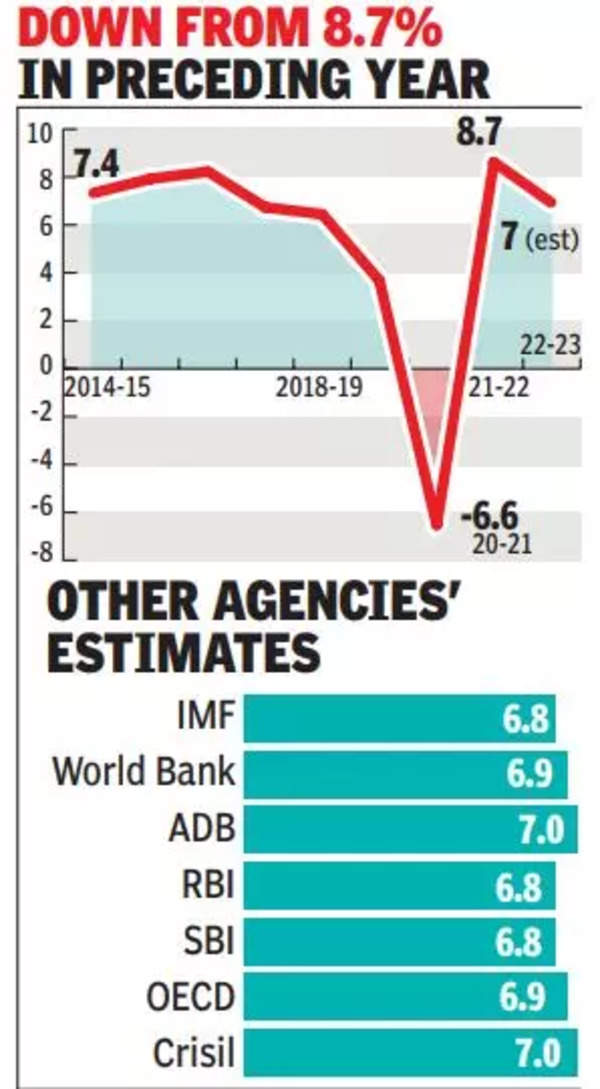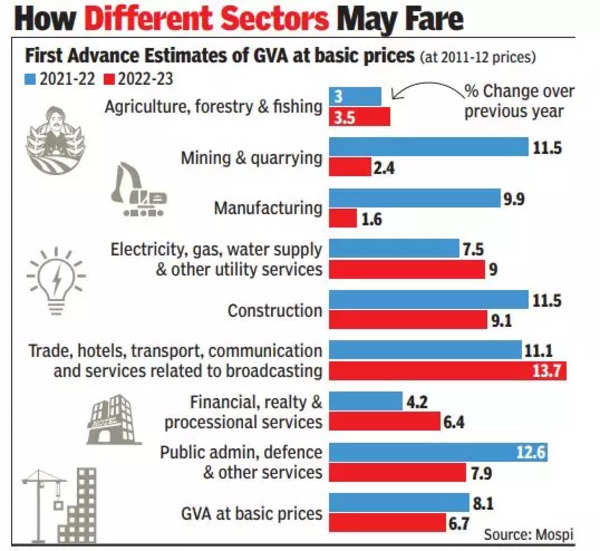GDP growth in 2022-23 seen at 7%: NSO’s advance estimates

[ad_1]
The first advance estimate for 2022-23 released by the National Statistical Office (NSO) on Friday estimated GDP growth at 7%, slower than the 8.7% expansion posted in 2021-22. The estimate is a shade higher than the Reserve Bank of India (RBI), which pegged it at 6.8%. Last month, the central bank cut its GDP growth forecast for 2022-23 citing accentuated headwinds from protracted geopolitical tensions, tightening global financial conditions and slowing external demand.

The International Monetary Fund (IMF) has also lowered India’s gross domestic product (GDP) growth projection for 2022-23 to 6.8% from the earlier 7.4%, citing the impact of a slowing global economy, stubborn inflation, rising interest rates and the Ukraine war.
Amid the global gloom, India will still retain the tag of the fastest growing thanks to robust domestic demand while China is expected to face a slowdown due to the impact of the lockdown to prevent the spread of Covid-19. The Indian economy has been scripting a recovery after the bruising impact of the Covid-19 pandemic but the global slowdown, the geopolitical situation, stubborn price pressures and the impact of rising interest rates have posed risks to faster expansion.

The data showed the farm sector is estimated to grow by 3.5% in 2022-23, higher than the 3% recorded in the previous year. The services sector has rebounded and is expected to grow 9.1%. The trade, hotels, transport, communication and services related to broadcasting is estimated to grow a robust 13.7% in 2022-23 compared to 11% growth in the previous year. The construction, helped by the government’s infrastructure push, is projected to grow by 9.1% compared to an 11.5% expansion in 2021-22.
The only laggard seems to be the manufacturing sector, which is expected to grow 1.6% in 2022-23 compared to 9.9% growth in 2021-22.
“Looking ahead, with challenges looming on the external front, India’s export growth is likely to moderate in FY24. The manufacturing sector will benefit from moderation in commodity prices but will feel the pain of lower external demand. In the services sector, there could be some fading of pent up demand that we saw in FY23,” said Rajani Sinha, chief economist at ratings agency CareEdge.
“While the government will continue its focus on capital spending, the main challenge will be a durable pick-up in private investment amid rising borrowing cost, demand uncertainty and global slowdown. Considering the headwinds arising on the external front and its possible spillovers on the Indian economy, we expect the GDP growth to moderate to around 6.1% in FY24,” said Sinha.
The NSO said these are early projections for 2022-23. Improved data coverage, actual tax collections and expenditure incurred on subsidies, data revisions made by source agencies. would have a bearing on subsequent revisions of these estimates, it added. Economists said the numbers are good for the government as it gets down to work on the Union budget, which would be unveiled early next month.
Fiscal deficit seen on track
The data showed the growth in nominal GDP ( which includes inflation) during 2022-23 is estimated at 15.4% as compared to 19.5% in 2021-22. “The primary purpose of the first advance estimates is to provide an estimate for nominal GDP growth for the upcoming Union budget, as it is used for preparing the revised fiscal deficit number for the current fiscal year.
The first advance estimate pegs nominal GDP at 15.4% for the current fiscal, against 11.1% estimated during Budget 2022,” said D K. Joshi, chief economist at ratings agency Crisil. “The upward revision in nominal GDP has given the government scope to increase fiscal deficit, while maintaining its proportion to GDP at the budget target. Given the latest update on nominal GDP, the government can increase the fiscal deficit by Rs 97,080 crore, while sticking to the budget target of fiscal deficit at 6.4% of GDP. This will help accommodate additional capital expenditure and subsidies incurred this year. Both fertiliser and food subsidy allocations were revised up significantly soon after the Budget announcement,” said Joshi in a note.
#GDP #growth #NSOs #advance #estimates





